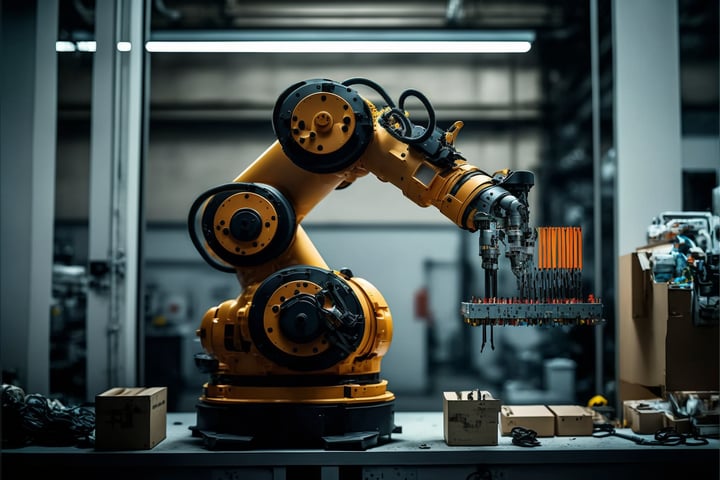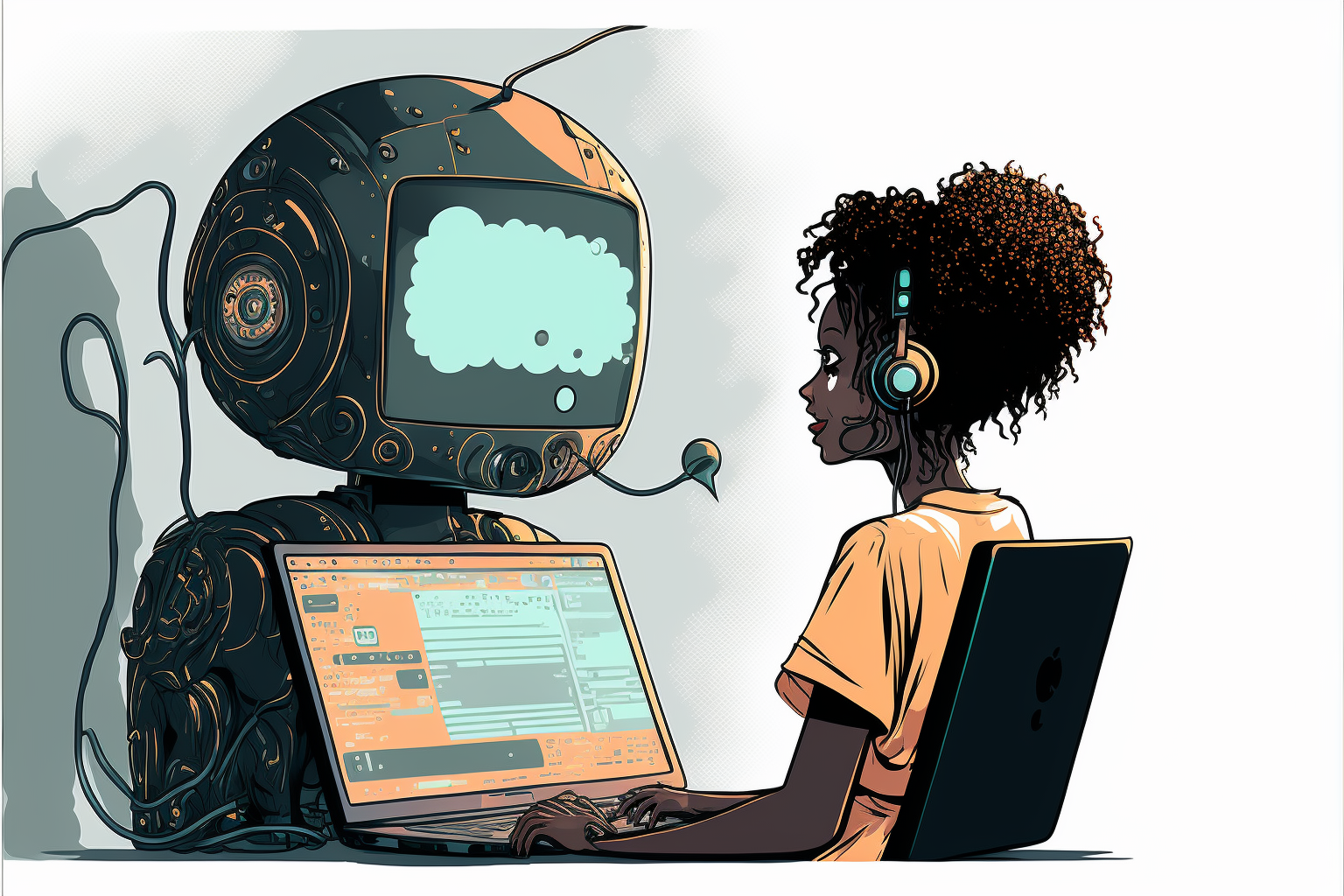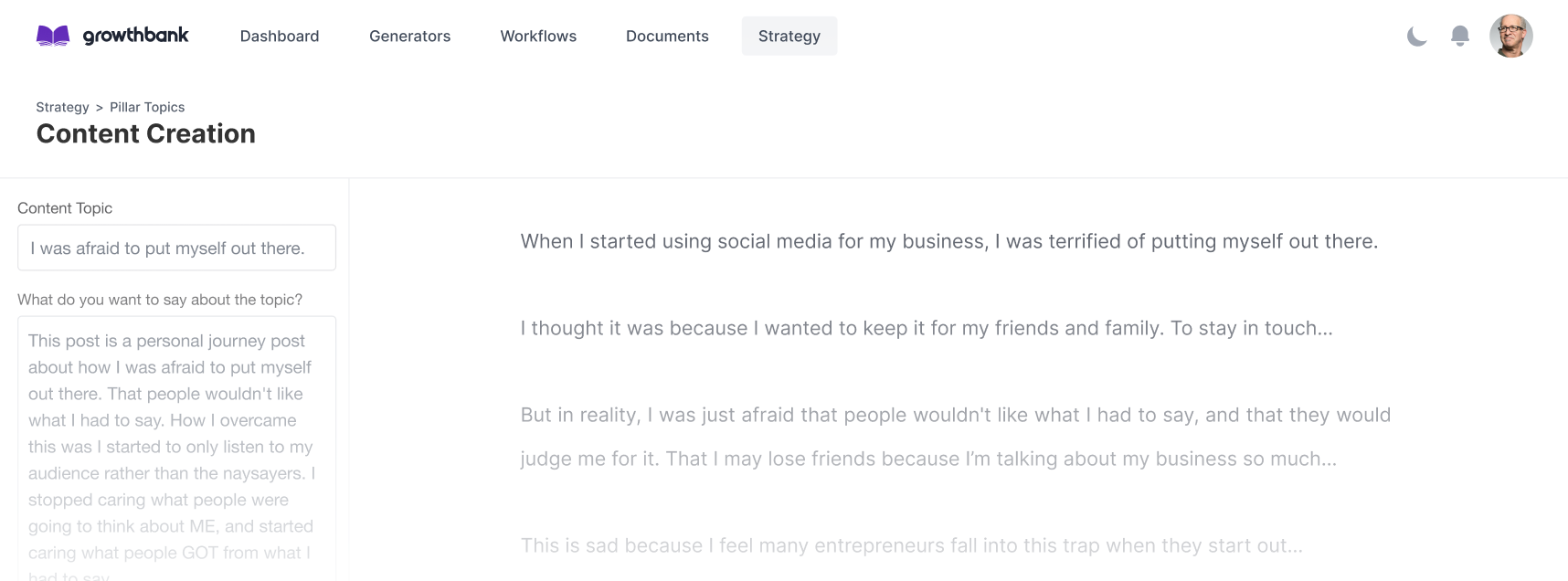
How often have you heard someone say they want to write their book or blog posts, but don’t know where to start? Or maybe you're a skilled copywriter and you’ve written...
Are you curious about the future of AI in the workplace? Artificial intelligence (AI) is becoming increasingly important in marketing and sales as technology advances. In this blog post, we will explore how AI will shape the future of work in this field. In addition, we'll look at how AI can help automate processes, improve customer service, and create more efficient teams. By the end of this article, readers will have a better understanding of how to utilize AI in their professional lives. So get ready to explore the future of AI in the workplace!

Automation of processes is the future of technology, and AI-driven automation is taking it to a new level. By streamlining workflows with AI, companies can improve their efficiency and increase productivity in ways never before possible. We will explore how AI-driven automation of tasks can help businesses streamline their processes and enable them to reach greater heights in terms of both productivity and profitability. In addition, we'll delve into how improved efficiency through automation helps organizations cut costs, increase customer service levels, maximize employee performance, and develop innovative growth strategies. With so much potential for innovation and cost savings from automated systems driven by AI technologies, it's no wonder why businesses are jumping on board. So, join us as we explore the exciting opportunities that automation of processes offers!
AI-driven automation of tasks is quickly becoming one of the most effective ways to streamline and optimize business operations. By leveraging artificial intelligence, companies can reduce costs, increase efficiency, and improve customer experience by automating mundane or repetitive tasks that would otherwise require manual labour. Various applications can use AI, such as natural language processing (NLP) for automated customer service interactions, computer vision for product sorting and inspection systems, predictive analytics for forecasting trends or demand planning optimization scenarios, and robotic process automation (RPA) to drive workflow automation.
Retail is one industry that has successfully implemented AI-driven automation. For example, automated checkout systems, such as Amazon Go and Walmart Express, are equipped with computer vision technology to detect when a customer has taken an item off the shelf—eliminating the need for manual checkout lines and reducing wait times for customers. Additionally, it helps improve inventory accuracy and reduce costs associated with labour. In addition, AI-driven automation is also being used in distribution centers to automate sorting products into bins or containers before they reach their final destination.
The benefits of AI-driven automation go beyond streamlining business operations - it can also help companies better understand their customers' needs and preferences by collecting data from automated interactions. Companies can use this data to make more informed decisions about product development, pricing strategies, and marketing campaigns. Additionally, AI-driven automation can help reduce the risk of errors or mistakes in workflows since it is not prone to human error like manual labour is. According to a report by McKinsey & Company, companies that are leveraging advanced automation technologies such as robotic process automation (RPA) are up to 60% more productive than those not.
Overall, business owners should consider implementing AI-driven automation solutions into their operations to improve efficiency and customer experience while reducing costs associated with traditional methods of operation. With the proper implementation strategy and technology partner, businesses can quickly realize returns on their investment and gain a competitive advantage in the market.
AI is revolutionizing the way businesses approach workflows. Streamlining processes through AI allows companies to maximize efficiency, reduce costs, and expand their capabilities. With AI-powered automation, teams can take on more complex tasks in less time and with fewer resources.
One example of how AI can help streamline a workflow is by automating repetitive activities such as data entry or document management. By leveraging machine learning algorithms, organizations can quickly process large amounts of information and make decisions based on the data. As a result, they are reducing the need for manual labour while enabling employees to focus on other essential tasks that require creative thinking skills rather than simply completing mundane paperwork. Additionally, this automation of processes can free up resources to focus on developing new products and services.
AI-powered workflows also can improve customer experience by allowing companies to respond quickly to queries, provide timely updates, or suggest personalized recommendations. AI-driven chatbots are becoming increasingly popular as they enable customers to get their answers quickly and accurately without waiting for a human representative. As a result, costs are reduced through faster response times and more accurate information, and customer satisfaction is increased.
Overall, AI has enabled businesses to reduce the time and resources spent on mundane tasks while increasing efficiency. In addition, by automating workflows with AI, companies can create more excellent customer value and increase their competitive edge in the market.
As technology advances, automation of processes is becoming increasingly popular as a method to improve efficiency in the workplace. Automation has been shown to reduce costs associated with manual labour and increase productivity across many industries. One way to leverage this technology is through improved efficiency via the automation of processes.
Automating existing tasks can significantly impact business operations by streamlining time-consuming activities such as data entry or customer service inquiries. Thus, eliminating any human error that may arise from manual processing ensures accuracy in all transactions in an organization. In addition, automating processes allows businesses to save money on labour costs while still providing quality services at scale due to increased speed and efficiency. Studies have shown that automation can reduce costs by up to 30%, with businesses saving an average of $8 billion yearly from automating processes.
Automation also has the potential to improve customer satisfaction, as automated services are often faster and more reliable than traditional manual processing methods. Furthermore, automated systems can give customers instant responses without requiring them to wait for human operators or submit multiple forms to complete a transaction. This is especially beneficial for companies offering online services, such as e-commerce stores or financial institutions, where an efficient and streamlined process could be their competitive advantage. Additionally, automation improves accuracy when dealing with large volumes of data which can be difficult for manual operators to manage.
Overall, improved efficiency through the automation of processes is a powerful tool that businesses can utilize to reduce costs, increase productivity, and improve customer satisfaction. Automation has the potential to revolutionize many industries by streamlining operations and transforming how organizations operate in an ever-evolving digital landscape.

Are you looking to up your customer service game? AI-powered chatbots and AI-driven personalization are two of the best ways to provide an improved customer service experience. With 24/7 support, customers can get help when needed, no matter the time or day. And with personalized experiences powered by AI, customers can expect a more tailored response that is better suited to their individual needs. Moreover, as AI technology improves accuracy in customer interactions, companies can ensure that customers get what they need even faster. Through this combination of technologies, companies can create an unparalleled customer service experience that keeps customers returning!
AI-powered chatbots are transforming the customer service industry and providing a 24/7 support option accessible to everyone. Chatbots have become increasingly sophisticated in recent years, utilizing Natural Language Processing (NLP) and Machine Learning algorithms to understand customers' needs more accurately than ever before. With AI-driven chatbot technology, businesses can provide personalized help quickly and effectively – regardless of the time or day – without requiring additional staffing resources.
Chatbots offer many benefits for businesses looking to improve their customer service offerings. On average, they can resolve up to 80 percent of customer inquiries without human intervention - allowing companies to save considerable time and money. Furthermore, AI-powered chatbots don't need to take breaks or vacations, meaning that customers can get their questions answered 24/7 - a great advantage for businesses in the increasingly competitive customer service market.
AI-powered chatbots are becoming more mainstream, with many industry leaders already investing heavily in the technology. For example, Microsoft has developed its bot platform, ' Bot Framework,' which allows companies to quickly create and deploy bots across multiple channels – from webpages to SMS messages. Clearly, this automated customer service is here to stay, as it provides an efficient, cost-effective way for businesses to offer personalized support – and it's only going to get better.
AI is revolutionizing the customer service experience and personalizing it in ways never before seen, leading to higher levels of customer satisfaction. AI allows companies to collect customer data, habits, and preferences quickly. This data can then be used to tailor more specific experiences to each customer's needs. For example, a retail store may use AI-powered chatbot technology to provide shoppers with personalized product recommendations based on their past purchases or interactions with the store's website.
Not only do these personalized customer experiences lead to increased sales potential for companies, but they also improved customer retention rates as well. With an AI system taking note of a customer's preferences and interactions, companies can provide customers with offers tailored to their needs. For example, this could be in the form of discounts on items they previously purchased or even free shipping for loyal customers. According to a recent study, as much as 85% of consumers are more likely to become repeat buyers when offered personalized experiences.
Furthermore, AI can also be used by customer service representatives to access relevant information about each customer's account quickly. As a result, they allow your representatives to provide faster resolution times and improve customer service overall. For example, AI-powered natural language processing technology is being used by some companies to automatically detect the intent behind emails and phone calls from customers so that customer service representatives can provide the most appropriate response.
Technology has revolutionized customer interactions, and the accuracy with which we can serve them has dramatically improved. With advancements in artificial intelligence, natural language processing, facial recognition and more, companies can better understand their customer's needs and provide tailored experiences. For example, by using AI-based chatbots on websites or applications, companies can quickly answer customer inquiries without needing an employee to respond manually. Additionally, facial recognition software allows businesses to eliminate human error when identifying customers at points of sale—resulting in increased accuracy while simultaneously improving business security measures.
Furthermore, data analytics tools have become increasingly helpful in gathering insights from customer interactions that allow businesses to refine their strategies. For example, by analyzing customer feedback, companies can identify customer preferences and trends and proactively address any issues that may arise. Additionally, predictive analytics anticipate customer needs and recommend products or services based on previous interactions. Therefore, allowing companies to target their marketing efforts better and build stronger customer relationships through tailored experiences.
Finally, technological advances have enabled real-time communication with customers, increasing customer service accuracy. For example, companies can now quickly respond to inquiries or provide updates on orders without the need for manual processes like phone calls or emails. Additionally, automated systems can guide customers through a step-by-step process to ensure accuracy and reduce error rates. This results in improved customer satisfaction and greater loyalty for businesses that invest in real-time communication capabilities.

The key to success for any team is collaboration. But working together can be difficult and time-consuming, especially when multiple people are involved. That's why AI-assisted collaboration tools are essential for optimizing team performance. AI can help teams collaborate more efficiently and effectively, from real-time brainstorming sessions to automated feedback analysis. We'll look at how AI-assisted collaboration tools can streamline the collaboration process and how AI can help optimize your team's performance overall. An AI assistant can help you manage tasks, maximize communication, make better decisions, share data, and analyze analytics - all made easier with an AI assistant.
Collaboration tools are revolutionizing how teams work together in today's business world. By leveraging advanced technologies such as natural language processing, machine learning and artificial intelligence, these tools enable employees to collaborate more efficiently than ever before. For example, with AI-driven solutions like voice recognition software and virtual assistants, team members can quickly search for the information they need without wasting time on manual data entry or searching through multiple document folders. Additionally, automated scheduling systems allow teams to stay organized and up-to-date with project timelines while saving them from unplanned meetings or further disruptions in their workflow.
Team performance and productivity have increased with AI technology within collaborative tools. For example, a recent study found that AI-assisted tools improved the accuracy of task completion by an average of 11%. Furthermore, these tools reduce the time spent on mundane tasks like data entry or scheduling meetings, allowing employees to focus on strategic tasks. This increased efficiency has resulted in higher employee satisfaction rates with their work environment and better collaboration between teams.
AI-assisted collaboration tools also provide access to real-time analytics, which allow managers and leaders to monitor team performance and measure progress against key goals. By tracking team activity over time, companies can identify issues or bottlenecks before they become significant problems. They allow you to develop strategies to improve collaboration and team performance from the data.
Overall, AI-assisted collaboration tools are revolutionizing how teams work by providing more efficient ways of working and allowing companies to stay on top of their team's progress. With these advanced technologies, businesses can ensure that their teams are productive and well-coordinated while reducing the time spent on mundane tasks. As a result, teams have increased efficiency,=, leading to higher employee satisfaction rates and better collaboration between departments.
Predictive analytics has become one of the most effective ways to enable better decision-making in teams. Predictive analytics uses data and algorithms to predict future outcomes based on past performance and trends. By using predictive analytics, teams can make more informed decisions about their future strategies, resources, and operations.
For example, a team may use predictive analytics to identify factors that lead to higher customer satisfaction or lower employee turnover rates. With this information, they can adjust their processes accordingly for improved results over time. In addition, you can use predictive analytics to forecast potential risks before they occur so you can take preemptive measures and prevent them from happening. This type of analytics helps teams make smarter decisions and reduce the chances of mistakes or delays that could cost them time, money, and resources.
Furthermore, you can also use predictive analytics to identify areas where further investments are needed to reach organizational goals faster. By understanding how various factors influence team performance on a macro level, teams can allocate their resources more efficiently for more significant results. For instance, a team may use predictive analytics to determine which new products should receive additional funding to maximize profits or better meet customer demands.
Overall, predictive analytics is invaluable for making better decisions within teams as it provides valuable insights into how different variables affect team performance. By leveraging this technology, teams can improve their decision-making processes and ultimately become more efficient in achieving their goals and objectives.
AI technology is revolutionizing the way companies manage their teams. As a result, employers can maximize productivity and reduce costs by optimizing team performance with AI. AI has already been used successfully in many industries to improve employee engagement, identify risks more quickly and efficiently, increase collaboration between departments, automate time-consuming tasks, and enhance decision-making processes.
One example of how AI can optimize a team's performance is through predictive analytics. Predictive analytics uses data from past experiences to predict future outcomes or trends for better-informed decisions about staffing and resources. For instance, a company might use predictive analytics to determine when employees will likely leave the organization based on past attrition rates—helping the employer identify potential talent gaps and plan to fill them with qualified new hires.
AI can also optimize team performance by improving collaboration between departments. AI-driven tools such as chatbots, project management software, and virtual assistants are helping teams communicate better, track processes more efficiently, and automate tedious tasks like data entry or customer service inquiries. These technologies enable teams to work together more smoothly while freeing time for other activities, such as brainstorming ideas or problem-solving. Additionally, AI technology can help employers make more thoughtful decisions around hiring practices by providing insights into job applicant profiles that may have otherwise gone unnoticed.
Overall, AI technology has the potential to revolutionize team performance by streamlining operations, improving collaboration between departments, and providing employers with valuable insights. By leveraging AI for team optimization, companies can gain a competitive edge in their respective industries.
The future of marketing and sales is being reshaped by artificial intelligence (AI). This blog post has explored various predictions about how AI can automate processes, improve customer service, and create more efficient teams. From utilizing AI-powered chatbots for 24/7 support to optimizing team performance with predictive analytics, readers now understand the potential of incorporating this technology into their professional lives. With GrowthBank's leading AI-Assisted Content Marketing Platform, you can unlock the power of artificial intelligence in your workplace today! Sign up for a free trial to start your journey toward success.

How often have you heard someone say they want to write their book or blog posts, but don’t know where to start? Or maybe you're a skilled copywriter and you’ve written...

Are you tired of writing dull, uninspiring headlines that fail to grab readers' attention? If so, you're not alone. In today's fast-paced world, it can be tough to stand...
If you want to see what it's like to write with GrowthBank, sign up for our private beta and save 20 or more hours every week.
